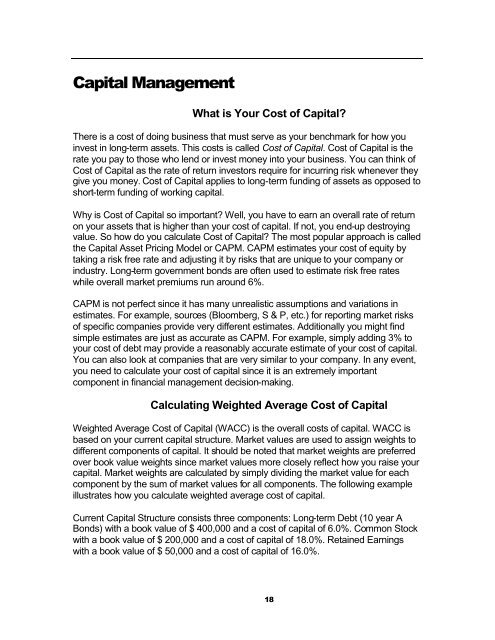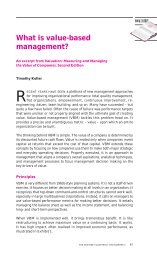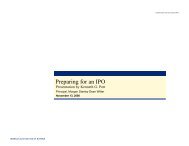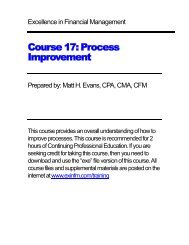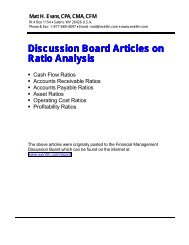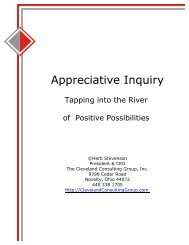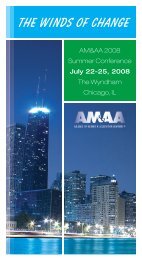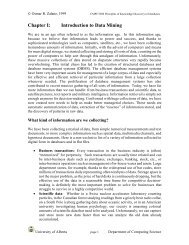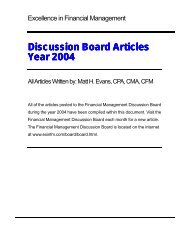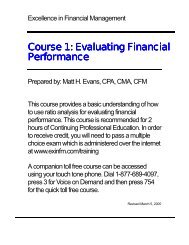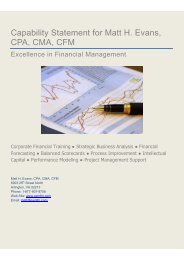Short Articles (PDF) - Excellence in Financial Management
Short Articles (PDF) - Excellence in Financial Management
Short Articles (PDF) - Excellence in Financial Management
You also want an ePaper? Increase the reach of your titles
YUMPU automatically turns print PDFs into web optimized ePapers that Google loves.
Capital <strong>Management</strong><br />
What is Your Cost of Capital<br />
There is a cost of do<strong>in</strong>g bus<strong>in</strong>ess that must serve as your benchmark for how you<br />
<strong>in</strong>vest <strong>in</strong> long-term assets. This costs is called Cost of Capital. Cost of Capital is the<br />
rate you pay to those who lend or <strong>in</strong>vest money <strong>in</strong>to your bus<strong>in</strong>ess. You can th<strong>in</strong>k of<br />
Cost of Capital as the rate of return <strong>in</strong>vestors require for <strong>in</strong>curr<strong>in</strong>g risk whenever they<br />
give you money. Cost of Capital applies to long-term fund<strong>in</strong>g of assets as opposed to<br />
short-term fund<strong>in</strong>g of work<strong>in</strong>g capital.<br />
Why is Cost of Capital so important Well, you have to earn an overall rate of return<br />
on your assets that is higher than your cost of capital. If not, you end-up destroy<strong>in</strong>g<br />
value. So how do you calculate Cost of Capital The most popular approach is called<br />
the Capital Asset Pric<strong>in</strong>g Model or CAPM. CAPM estimates your cost of equity by<br />
tak<strong>in</strong>g a risk free rate and adjust<strong>in</strong>g it by risks that are unique to your company or<br />
<strong>in</strong>dustry. Long-term government bonds are often used to estimate risk free rates<br />
while overall market premiums run around 6%.<br />
CAPM is not perfect s<strong>in</strong>ce it has many unrealistic assumptions and variations <strong>in</strong><br />
estimates. For example, sources (Bloomberg, S & P, etc.) for report<strong>in</strong>g market risks<br />
of specific companies provide very different estimates. Additionally you might f<strong>in</strong>d<br />
simple estimates are just as accurate as CAPM. For example, simply add<strong>in</strong>g 3% to<br />
your cost of debt may provide a reasonably accurate estimate of your cost of capital.<br />
You can also look at companies that are very similar to your company. In any event,<br />
you need to calculate your cost of capital s<strong>in</strong>ce it is an extremely important<br />
component <strong>in</strong> f<strong>in</strong>ancial management decision-mak<strong>in</strong>g.<br />
Calculat<strong>in</strong>g Weighted Average Cost of Capital<br />
Weighted Average Cost of Capital (WACC) is the overall costs of capital. WACC is<br />
based on your current capital structure. Market values are used to assign weights to<br />
different components of capital. It should be noted that market weights are preferred<br />
over book value weights s<strong>in</strong>ce market values more closely reflect how you raise your<br />
capital. Market weights are calculated by simply divid<strong>in</strong>g the market value for each<br />
component by the sum of market values for all components. The follow<strong>in</strong>g example<br />
illustrates how you calculate weighted average cost of capital.<br />
Current Capital Structure consists three components: Long-term Debt (10 year A<br />
Bonds) with a book value of $ 400,000 and a cost of capital of 6.0%. Common Stock<br />
with a book value of $ 200,000 and a cost of capital of 18.0%. Reta<strong>in</strong>ed Earn<strong>in</strong>gs<br />
with a book value of $ 50,000 and a cost of capital of 16.0%.<br />
18


